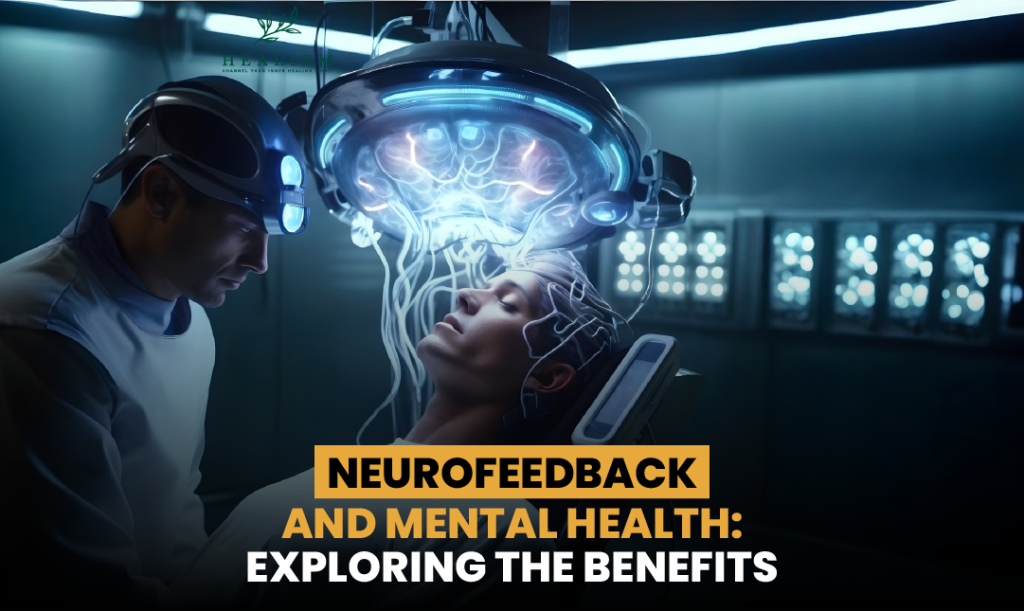
Our mental health is important to how we feel and function, but sometimes we overlook it. Lately, neurofeedback is gaining attention for boosting mental health.
This post will dive into the benefits of neurofeedback, the process, and what you can expect from this cutting-edge therapy.
We will also explore the differences between biofeedback and neurofeedback, possible side effects, and how to find a neurofeedback therapist near you.
What is Neurofeedback?
Neurofeedback, or EEG biofeedback, is a unique therapy. It observes brain activity in real-time to teach brain to self-regulate.
It places monitors on the head to check brainwave speed and gives feedback to the person—this helps us perceive and alter our brainwave patterns.
How Neurofeedback Works
The Science Behind Neurofeedback
Neurofeedback is based on the idea that we can coach the brain to work better.
There are a few kinds of brainwaves in the brain like alpha, beta, delta, and theta waves. Each kind ties to various mind states, such as consciousness, like relaxation, focus, or sleep.
Neurofeedback aims to balance these brainwaves, promoting optimal brain function.
The Neurofeedback Process
- Initial Assessment: It all starts with an evaluation by a skilled neurofeedback expert. This check-up involves a QEEG (quantitative electroencephalogram) to chart brain activity and pinpoint areas that need improvement.
- Training Sessions: In training sessions, monitors are set on the head to watch brain patterns. The person takes part in things that give immediate responses, like enjoying a film or gaming. When brain patterns hit the wanted level, the activity continues, strengthening positive brain patterns.
- Progress Monitoring: As time passes, the brain picks up how to keep these optimal patterns on its own. Regular check-ups are used to track how well the therapy is working.
Neurofeedback Benefits
Improved Mental Health
Neurofeedback’s main benefit? It boosts mental health. It’s been proven to lower anxiety, depression, and PTSD symptoms. An improved brain equals better moods, less stress, and stronger emotional resilience.
Enhanced Cognitive Function
Neurofeedback is also beneficial for cognitive function. It fine-tunes focus, attention, and memory which is great for people with ADHD or learning difficulties. A stronger mind means doing better in school or work.
Better Sleep Patterns
Sleep issues can harm mental health. Neurofeedback helps by guiding the brain to the right brainwaves for a good sleep. This helps you feel good overall and function well during the day.
Reduced Symptoms of Neurological Disorders
Neurofeedback can reduces the symptoms of epilepsy, migraines, and brain injury issues. It helps the brain work better, lessening these problems. This enhances your life quality.
Biofeedback vs Neurofeedback
What is Biofeedback?
Biofeedback is a term that includes different ways to master control over body functions such as heart pulse, muscle stiffness, and skin heat.
Like neurofeedback, biofeedback uses detectors and live feedback to promote self-regulation.
Main Differences
- Focus: Biofeedback aims at body functions, while neurofeedback centers on brain activity.
- Techniques: Biofeedback might involve methods like heart beat variability training and electromyography, whereas neurofeedback employs EEG to track brainwaves.
- Applications: Biofeedback is commonly applied to issues like high blood pressure and persistent pain, while neurofeedback is mostly used for mental and brain-concerns.
Some Possible Neurofeedback Side Effects
Common Side Effects
Neurofeedback is often safe, yet it may cause some minor side effects in some people.
- Fatigue: Some people may feel tired after their first few sessions as the brain learns new patterns.
- Headaches: A few might get mild headaches post-session.
- Temporary Discomfort: Some might feel agitated or uncomfortable, but this is just the brain adapting.
Rare Side Effects
Some people might feel heightened worry or mood changes. Tell your neurofeedback therapist if you experience any of these effects so they can adjust the protocol as needed.
Finding Neurofeedback Therapists Near You
Research and Referrals
It’s vital to find a good neurofeedback therapist for the best results. Start with an internet search to find local clinics and therapists. You can also check their ratings and reviews.
Try asking other doctors or support groups for recommendations.
Certification and Experience
Make sure your therapist has a certification from a well-known organization like the Biofeedback Certification International Alliance (BCIA). This shows that they have passed required training and keep professional rules.
Also, ask if they have worked with cases similar to yours.
Initial Consultation
Ask for an initial consultation to talk about your mental health goals and concerns. In this meeting, you can also see if the therapist’s approach is right for you.
Feel free to ask them about their techniques, how effective they are, and what you can expect from therapy.
What to Expect During Neurofeedback Therapy
Initial Assessment
To start off therapy, a complete evaluation is done, using a QEEG to survey your brain’s activity. This check helps areas of dysregulation that need improvement.
Training Sessions
These sessions are 30-60 minutes long, happening once or twice weekly. You will participate in tasks giving live feedback of your brainwaves. The goal is to reinforce positive patterns and reduce negative ones.
Progress and Adjustments
Progress is monitored through regular assessments. The training routine might be adjusted based on your strides forward, for best outcomes. Generally, people start seeing betterment after 10-20 sessions. However, the total sessions needed depend on personal needs.
Long-Term Benefits
Neurofeedback’s long-lasting advantages can be immense. With your brain getting used to keeping optimal patterns, you’ll see ongoing betterments in mental health, cognitive function, and overall well-being.
Conclusion: Embrace the Power of Neurofeedback
Neurofeedback, with its mental health benefits, shows potential. It can improve mood, help cognitive function, improve sleep, and lessen the symptoms of neurological disorders.
Knowing how neurofeedback works and what to expect, you can decide if this therapy fits your needs.
Take Action with Healizm
Ready for the impactful change neurofeedback can make? At Healizm, we specialize in personalized neurofeedback therapy for your unique needs.
Our certified therapist can help you achieve optimal mental health and well-being.
Get in touch with Healizm to book your appointment and journey towards improved mental health.
FAQs
-
What are the benefits of neurofeedback?
Neurofeedback offers numerous benefits, like:
- Better mental health
- Enhanced cognitive function
- Better sleep patterns
- Reduced symptoms of neurological disorders such as epilepsy and migraines
Your brain learns the best way to work, which can decrease symptoms of anxiety, depression, and PTSD as well. This leads to feeling better overall.
-
Why may neurofeedback be a powerful depression treatment?
With neurofeedback, we have a strong tool to fight depression. It tunes brain activity tied to emotions. It’s all about balancing those brainwaves.
As a result, you’ll feel emotionally stronger and less affected by depressive feelings. And what’s more? It’s non-invasive and doesn’t require medication.
-
How can I improve my mental and emotional health?
Enhancing mental and emotional well-being is a blend of lifestyle shifts, professional aid, and self-care routines.
Exercise, proper diet, plenty of sleep, and stress control methods like being mindful and meditation helps.
Specialists offer treatments, including neurofeedback, which work well for particular mental health requirements.
-
How does mental health affect your health?
Mental health has a big role in complete health. If mental health suffers, it can create lasting conditions like heart issues, diabetes, and poor immunity. It changes everyday tasks, social appeals, and life satisfaction. On the flip side, strong mental health aids physical health, thought processes, and feeling content.
-
Can neurofeedback damage your brain?
Neurofeedback is typically harmless and non-invasive. It applies instant feedback to teach the brain to self-regulate without injury. But, a few might encounter mild issues such as tiredness or headaches.
It’s vital to consult a certified therapist to lessen any hazards and validate the treatment suits you.
-
Neurofeedback therapy for trauma—does it work?
Neurofeedback therapy aids trauma victims by regulating brain activity disrupted by traumatic events. It aids in reducing symptoms of PTSD, worry, and emotional disorder, enabling people to digest and overpower trauma more effectively. Regular sessions create lasting advancement in emotional balance and mental health.
-
How much is neurofeedback therapy?
Neurofeedback therapy’s charges can differ. Factors such as location, therapist’s expertise, and number of sessions needed play a role.
Typically, a single session might be $100 to $250. It’s important to discuss costs in the initial consultation and check on insurance or payment options.
-
What are the types of neurofeedback?
There are various forms of neurofeedback, such as:
- QEEG-guided neurofeedback, which uses QEEG to create a customized brain map.
- Infra-low frequency neurofeedback works on very low brain frequencies.
- Alpha-theta neurofeedback focuses on specific brain states for calming and emotional work.
- Hemoencephalography (HEG) tracks and adjusts the brain’s blood flow.
Each type gives different benefits. Thus, you should consult with a therapist to choose what works best for you.
